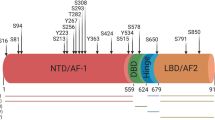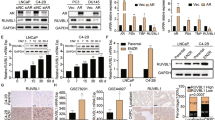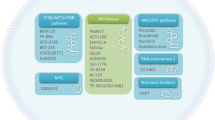Abstract
Prostate cancer is the most frequently diagnosed cancer in American men. We have previously demonstrated that Src mediates androgen-independent proliferation in prostate cancer. We sought to investigate the Src-mediated oncogenic pathways and tumor biology using AZD0530, a novel Src family kinase/Abl dual-kinase inhibitor that is entering phase II clinical trials. We show that while both Src and Abl are expressed in all prostate cancer cell lines, Src but not Abl is activated in the prostate. Furthermore, Src activation is inhibited by AZD0530 in a rapid and dose-dependent manner. We show that Src mediates cell proliferation in DU145 and PC3 cells at the G1 phase of cell cycle. Src inhibition resulted in decreased binding of β-catenin to the promoters of G1 phase cell cycle regulators cyclin D1 and c-Myc. C-Myc may also be regulated at the protein level by extracellular signal-regulated kinase 1/2 and GSK3β. Cell motility factors focal adhesion kinase, p130CAS and paxillin activation in DU145 and PC3 cells were also inhibited. Administration of AZD0530 in mice reduced orthotopic DU145 xenograft growth by 45%. We have further delineated the Src-mediated oncogenic growth and migration pathways in prostate cancer and established mechanistic rationale for Src inhibition as novel therapy in the treatment of prostate cancer.
This is a preview of subscription content, access via your institution
Access options
Subscribe to this journal
Receive 50 print issues and online access
$259.00 per year
only $5.18 per issue
Buy this article
- Purchase on Springer Link
- Instant access to full article PDF
Prices may be subject to local taxes which are calculated during checkout





Similar content being viewed by others
References
Albanese C, Johnson J, Watanabe G, Eklund N, Vu D, Arnold A et al. (1995). Transforming p21ras mutants and c-Ets-2 activate the cyclin D1 promoter through distinguishable regions. J Biol Chem 270: 23589–23597.
Bang YJ, Pirnia F, Fang WG, Kang WK, Sartor O, Whitesell L et al. (1994). Terminal neuroendocrine differentiation of human prostate carcinoma cells in response to increased intracellular cyclic AMP. Proc Natl Acad Sci USA 91: 5330–5334.
Barone MV, Courtneidge SA . (1995). Myc but not Fos rescue of PDGF signalling block caused by kinase-inactive Src. Nature 378: 509–512.
Biscardi JS, Ishizawar RC, Silva CM, Parsons SJ . (2000). Tyrosine kinase signalling in breast cancer: epidermal growth factor receptor and c-Src interactions in breast cancer. Breast Cancer Res 2: 203–210.
Bjelfman C, Meyerson G, Cartwright CA, Mellstrom K, Hammerling U, Pahlman S . (1990). Early activation of endogenous pp60src kinase activity during neuronal differentiation of cultured human neuroblastoma cells. Mol Cell Biol 10: 361–370.
Bowman T, Broome MA, Sinibaldi D, Wharton W, Pledger WJ, Sedivy JM et al. (2001). Stat3-mediated Myc expression is required for Src transformation and PDGF-induced mitogenesis. Proc Natl Acad Sci USA 98: 7319–7324.
Bromann PA, Korkaya H, Courtneidge SA . (2004). The interplay between Src family kinases and receptor tyrosine kinases. Oncogene 23: 7957–7968.
Chang YM, Kung HJ, Evans CP . (2007). Nonreceptor tyrosine kinases in prostate cancer. Neoplasia 9: 90–100.
Chen G, Shukeir N, Potti A, Sircar K, Aprikian A, Goltzman D et al. (2004). Up-regulation of Wnt-1 and beta-catenin production in patients with advanced metastatic prostate carcinoma: potential pathogenetic and prognostic implications. Cancer 101: 1345–1356.
Cheng JQ, Lindsley CW, Cheng GZ, Yang H, Nicosia SV . (2005). The Akt/PKB pathway: molecular target for cancer drug discovery. Oncogene 24: 7482–7492.
Cronauer MV, Schulz WA, Ackermann R, Burchardt M . (2005). Effects of WNT/beta-catenin pathway activation on signaling through T-cell factor and androgen receptor in prostate cancer cell lines. Int J Oncol 26: 1033–1040.
Cross DA, Alessi DR, Cohen P, Andjelkovich M, Hemmings BA . (1995). Inhibition of glycogen synthase kinase-3 by insulin mediated by protein kinase B. Nature 378: 785–789.
Daaka Y . (2002). Mitogenic action of LPA in prostate. Biochim Biophys Acta 1582: 265–269.
de la Taille A, Rubin MA, Chen MW, Vacherot F, de Medina SG, Burchardt M et al. (2003). Beta-catenin-related anomalies in apoptosis-resistant and hormone-refractory prostate cancer cells. Clin Cancer Res 9: 1801–1807.
Desai SJ, Ma AH, Tepper CG, Chen HW, Kung HJ . (2006). Inappropriate activation of the androgen receptor by nonsteroids: involvement of the Src kinase pathway and its therapeutic implications. Cancer Res 66: 10449–10459.
Devi GR, Oldenkamp JR, London CA, Iversen PL . (2002). Inhibition of human chorionic gonadotropin beta-subunit modulates the mitogenic effect of c-myc in human prostate cancer cells. Prostate 53: 200–210.
Diehl JA, Cheng M, Roussel MF, Sherr CJ . (1998). Glycogen synthase kinase-3beta regulates cyclin D1 proteolysis and subcellular localization. Genes Dev 12: 3499–3511.
Dominguez-Sola D, Dalla-Favera R . (2004). PINning down the c-Myc oncoprotein. Nat Cell Biol 6: 288–289.
Dong JT . (2006). Prevalent mutations in prostate cancer. J Cell Biochem 97: 433–447.
Evans CP, Walsh DS, Kohn EC . (1991). An autocrine motility factor secreted by the Dunning R-3327 rat prostatic adenocarcinoma cell subtype AT2.1. Int J Cancer 49: 109–113.
Farkas A, Szatmari E, Orbok A, Wilhelm I, Wejksza K, Nagyoszi P et al. (2005). Hyperosmotic mannitol induces Src kinase-dependent phosphorylation of beta-catenin in cerebral endothelial cells. J Neurosci Res 80: 855–861.
Furstoss O, Dorey K, Simon V, Barila D, Superti-Furga G, Roche S . (2002). c-Abl is an effector of Src for growth factor-induced c-myc expression and DNA synthesis. EMBO J 21: 514–524.
Gao L, Zhang L, Hu J, Li F, Shao Y, Zhao D et al. (2005). Down-regulation of signal transducer and activator of transcription 3 expression using vector-based small interfering RNAs suppresses growth of human prostate tumor in vivo. Clin Cancer Res 11: 6333–6341.
Golas JM, Arndt K, Etienne C, Lucas J, Nardin D, Gibbons J et al. (2003). SKI-606, a 4-anilino-3-quinolinecarbonitrile dual inhibitor of Src and Abl kinases, is a potent antiproliferative agent against chronic myelogenous leukemia cells in culture and causes regression of K562 xenografts in nude mice. Cancer Res 63: 375–381.
Gray MJ, Zhang J, Ellis LM, Semenza GL, Evans DB, Watowich SS et al. (2005). HIF-1alpha, STAT3, CBP/p300 and Ref-1/APE are components of a transcriptional complex that regulates Src-dependent hypoxia-induced expression of VEGF in pancreatic and prostate carcinomas. Oncogene 24: 3110–3120.
Guo Z, Dai B, Jiang T, Xu K, Xie Y, Kim O et al. (2006). Regulation of androgen receptor activity by tyrosine phosphorylation. Cancer Cell 10: 309–319.
Hakak Y, Martin GS . (1999). Ubiquitin-dependent degradation of active Src. Curr Biol 9: 1039–1042.
Hauck CR, Hsia DA, Puente XS, Cheresh DA, Schlaepfer DD . (2002). FRNK blocks v-Src-stimulated invasion and experimental metastases without effects on cell motility or growth. EMBO J 21: 6289–6302.
Hennequin LF, Allen J, Breed J, Curwen J, Fennell M, Green TP et al. (2006). N-(5-Chloro-1,3-benzodioxol-4-yl)-7-[2-(4-methylpiperazin-1-yl)ethoxy]-5- (tetrahydro-2H-pyran-4-yloxy)quinazolin-4-amine, a novel, highly selective, orally available, dual-specific c-Src/Abl kinase inhibitor. J Med Chem 49: 6465–6488.
Hiscox S, Morgan L, Green TP, Barrow D, Gee J, Nicholson RI . (2006). Elevated Src activity promotes cellular invasion and motility in tamoxifen resistant breast cancer cells. Breast Cancer Res Treat 97: 263–274.
Jemal A, Siegel R, Ward E, Hao Y, Xu J, Murray T et al. (2008). Cancer statistics, 2008. CA Cancer J Clin 58: 71–96.
Karni R, Gus Y, Dor Y, Meyuhas O, Levitzki A . (2005). Active Src elevates the expression of beta-catenin by enhancement of cap-dependent translation. Mol Cell Biol 25: 5031–5039.
Kim D, Rath O, Kolch W, Cho KH . (2007). A hidden oncogenic positive feedback loop caused by crosstalk between Wnt and ERK pathways. Oncogene 26: 4571–4579.
Kotha A, Sekharam M, Cilenti L, Siddiquee K, Khaled A, Zervos AS et al. (2006). Resveratrol inhibits Src and Stat3 signaling and induces the apoptosis of malignant cells containing activated Stat3 protein. Mol Cancer Ther 5: 621–629.
Lee D, Gautschi O . (2006). Clinical development of SRC tyrosine kinase inhibitors in lung cancer. Clin Lung Cancer 7: 381–384.
Lee LF, Guan J, Qiu Y, Kung HJ . (2001). Neuropeptide-induced androgen independence in prostate cancer cells: roles of nonreceptor tyrosine kinases Etk/Bmx, Src, and focal adhesion kinase. Mol Cell Biol 21: 8385–8397.
Lee LF, Louie MC, Desai SJ, Yang J, Chen HW, Evans CP et al. (2004). Interleukin-8 confers androgen-independent growth and migration of LNCaP: differential effects of tyrosine kinases Src and FAK. Oncogene 23: 2197–2205.
Li G, Qian H . (2003). Sensitivity and specificity amplification in signal transduction. Cell Biochem Biophys 39: 45–59.
Lombardo LJ, Lee FY, Chen P, Norris D, Barrish JC, Behnia K et al. (2004). Discovery of N-(2-chloro-6-methyl- phenyl)-2-(6-(4-(2-hydroxyethyl)- piperazin-1-yl)-2-methylpyrimidin-4- ylamino)thiazole-5-carboxamide (BMS-354825), a dual Src/Abl kinase inhibitor with potent antitumor activity in preclinical assays. J Med Chem 47: 6658–6661.
Morin PJ . (1999). beta-catenin signaling and cancer. Bioessays 21: 1021–1030.
Nam S, Buettner R, Turkson J, Kim D, Cheng JQ, Muehlbeyer S et al. (2005a). Indirubin derivatives inhibit Stat3 signaling and induce apoptosis in human cancer cells. Proc Natl Acad Sci USA 102: 5998–6003.
Nam S, Kim D, Cheng JQ, Zhang S, Lee JH, Buettner R et al. (2005b). Action of the Src family kinase inhibitor, dasatinib (BMS-354825), on human prostate cancer cells. Cancer Res 65: 9185–9189.
Park SI, Zhang J, Phillips KA, Araujo JC, Najjar AM, Volgin AY et al. (2008). Targeting SRC family kinases inhibits growth and lymph node metastases of prostate cancer in an orthotopic nude mouse model. Cancer Res 68: 3323–3333.
Parsons JT . (2003). Focal adhesion kinase: the first ten years. J Cell Sci 116: 1409–1416.
Planas-Silva MD, Bruggeman RD, Grenko RT, Stanley Smith J . (2006). Role of c-Src and focal adhesion kinase in progression and metastasis of estrogen receptor-positive breast cancer. Biochem Biophys Res Commun 341: 73–81.
Prathapam T, Tegen S, Oskarsson T, Trumpp A, Martin GS . (2006). Activated Src abrogates the Myc requirement for the G0/G1 transition but not for the G1/S transition. Proc Natl Acad Sci USA 103: 2695–2700.
Qiu Y, Robinson D, Pretlow TG, Kung HJ . (1998). Etk/Bmx, a tyrosine kinase with a pleckstrin-homology domain, is an effector of phosphatidylinositol 3′-kinase and is involved in interleukin 6-induced neuroendocrine differentiation of prostate cancer cells. Proc Natl Acad Sci USA 95: 3644–3649.
Quelle DE, Ashmun RA, Shurtleff SA, Kato JY, Bar-Sagi D, Roussel MF et al. (1993). Overexpression of mouse D-type cyclins accelerates G1 phase in rodent fibroblasts. Genes Dev 7: 1559–1571.
Roura S, Miravet S, Piedra J, Garcia de Herreros A, Dunach M . (1999). Regulation of E-cadherin/Catenin association by tyrosine phosphorylation. J Biol Chem 274: 36734–36740.
Rovin JD, Frierson Jr HF, Ledinh W, Parsons JT, Adams RB . (2002). Expression of focal adhesion kinase in normal and pathologic human prostate tissues. Prostate 53: 124–132.
Schaller MD . (2001). Biochemical signals and biological responses elicited by the focal adhesion kinase. Biochim Biophys Acta 1540: 1–21.
Sears RC . (2004). The life cycle of C-myc: from synthesis to degradation. Cell Cycle 3: 1133–1137.
Slack JK, Adams RB, Rovin JD, Bissonette EA, Stoker CE, Parsons JT . (2001). Alterations in the focal adhesion kinase/Src signal transduction pathway correlate with increased migratory capacity of prostate carcinoma cells. Oncogene 20: 1152–1163.
Steiner MS, Anthony CT, Lu Y, Holt JT . (1998). Antisense c-myc retroviral vector suppresses established human prostate cancer. Hum Gene Ther 9: 747–755.
Stephenson RA, Dinney CP, Gohji K, Ordonez NG, Killion JJ, Fidler IJ . (1992). Metastatic model for human prostate cancer using orthotopic implantation in nude mice. J Natl Cancer Inst 84: 951–957.
Taj MM, Tawil RJ, Engstrom LD, Zeng Z, Hwang C, Sanda MG et al. (2001). Mxi1, a Myc antagonist, suppresses proliferation of DU145 human prostate cells. Prostate 47: 194–204.
Tsai YT, Su YH, Fang SS, Huang TN, Qiu Y, Jou YS et al. (2000). Etk, a Btk family tyrosine kinase, mediates cellular transformation by linking Src to STAT3 activation. Mol Cell Biol 20: 2043–2054.
Unni E, Sun S, Nan B, McPhaul MJ, Cheskis B, Mancini MA et al. (2004). Changes in androgen receptor nongenotropic signaling correlate with transition of LNCaP cells to androgen independence. Cancer Res 64: 7156–7168.
Verras M, Sun Z . (2006). Roles and regulation of Wnt signaling and beta-catenin in prostate cancer. Cancer Lett 237: 22–32.
Vinall RL, Tepper CG, Shi XB, Xue LA, Gandour-Edwards R, de Vere White RW . (2006). The R273H p53 mutation can facilitate the androgen-independent growth of LNCaP by a mechanism that involves H2 relaxin and its cognate receptor LGR7. Oncogene 25: 2082–2093.
Watanabe G, Howe A, Lee RJ, Albanese C, Shu IW, Karnezis AN et al. (1996). Induction of cyclin D1 by simian virus 40 small tumor antigen. Proc Natl Acad Sci USA 93: 12861–12866.
Yeatman TJ . (2004). A renaissance for SRC. Nat Rev Cancer 4: 470–480.
Yuan ZL, Guan YJ, Chatterjee D, Chin YE . (2005). Stat3 dimerization regulated by reversible acetylation of a single lysine residue. Science 307: 269–273.
Zhu S, Bjorge JD, Fujita DJ . (2007). PTP1B contributes to the oncogenic properties of colon cancer cells through Src activation. Cancer Res 67: 10129–10137.
Acknowledgements
This study was supported by National Institutes of Health Grant KO8 DK60748-01 (CPE), RO1 DK52659 (H-JK) and Department of Defense Grant PC040161 (CPE). The contents of this report are solely the responsibility of the authors and do not necessarily represent the official views of the National Institutes of Health or the Department of Defense.
Author information
Authors and Affiliations
Corresponding authors
Rights and permissions
About this article
Cite this article
Chang, YM., Bai, L., Liu, S. et al. Src family kinase oncogenic potential and pathways in prostate cancer as revealed by AZD0530. Oncogene 27, 6365–6375 (2008). https://doi.org/10.1038/onc.2008.250
Received:
Revised:
Accepted:
Published:
Issue Date:
DOI: https://doi.org/10.1038/onc.2008.250
Keywords
This article is cited by
-
Epstein-Barr viral product-containing exosomes promote fibrosis and nasopharyngeal carcinoma progression through activation of YAP1/FAPα signaling in fibroblasts
Journal of Experimental & Clinical Cancer Research (2022)
-
FYN is required for ARHGEF16 to promote proliferation and migration in colon cancer cells
Cell Death & Disease (2020)
-
Targeting Src family kinase member Fyn by Saracatinib attenuated liver fibrosis in vitro and in vivo
Cell Death & Disease (2020)
-
EPHB4 inhibition activates ER stress to promote immunogenic cell death of prostate cancer cells
Cell Death & Disease (2019)
-
Suppression of lung cancer progression by isoliquiritigenin through its metabolite 2, 4, 2’, 4’-Tetrahydroxychalcone
Journal of Experimental & Clinical Cancer Research (2018)



